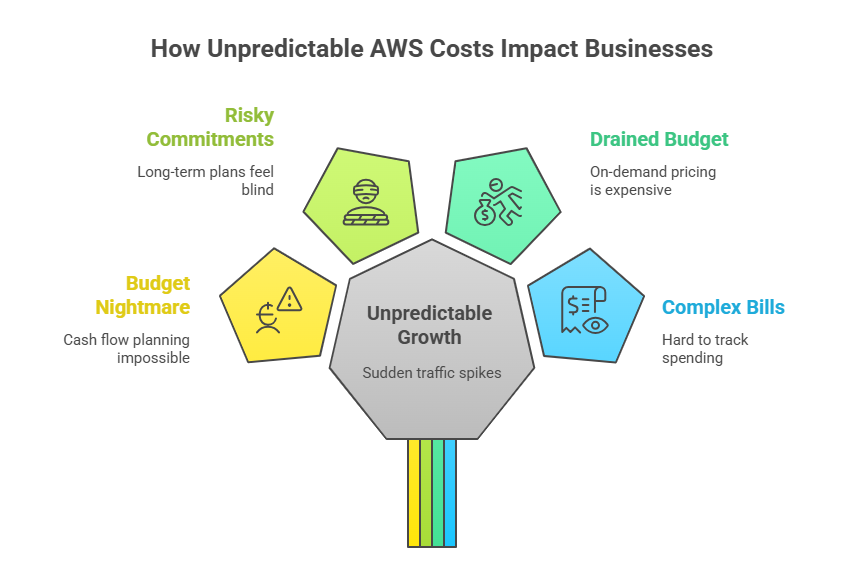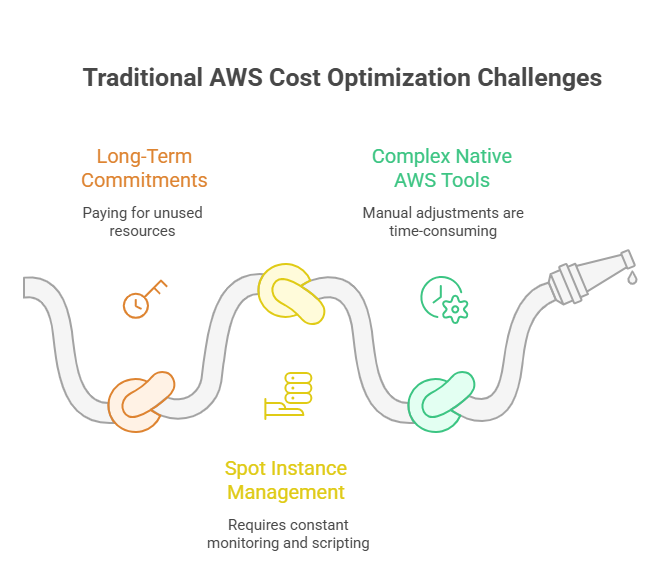Published
- 11 min read
How to Implement Cost Optimisation on AWS for Growing Teams?

Key Highlights
- Cost optimisation on AWS is critical for growing companies to keep cloud bills predictable while scaling.
- Startups and SMBs overspend due to unpredictable growth, expensive on-demand pricing, and the complexity of AWS bills.
- Long-term AWS plans like Reserved Instances don’t work for small teams because they require risky 1–3 year commitments.
- Kuberns delivers up to 40% AWS savings instantly with no setup complexity or DevOps overhead.
Introduction
If you’re using the cloud to run your business, chances are AWS is part of your setup. It’s flexible, powerful, and trusted by companies of every size. But as usage grows, so does the bill, often faster than revenue. What starts as a cost-effective choice in the early stages can quickly become a financial burden for growing companies.
This is where cost optimisation on AWS comes in.
It’s not just about reducing expenses. It’s about ensuring that your cloud spend matches your growth stage. For SMBs, Startups and enterprises, this planning can mean the difference between protecting margins or burning through budgets.
But the challenge?
Traditional approaches to AWS cost optimisation involve complex pricing models, long-term commitments, or dedicated DevOps teams.
Most smaller companies simply don’t have the time or resources for that. That’s why many are turning to platforms like Kuberns, which deliver up to 40% AWS savings instantly without extra setup or complexity.
Let’s first look at what cost optimisation on AWS actually means for a growing company.
What Is Cost Optimisation on AWS?

At its core, cost optimisation on AWS means making sure every dollar you spend on the cloud delivers actual business value.
It’s not about slashing services to the point of hurting performance, but about using AWS in the most efficient way possible.
For growing companies, that usually involves:
- Keeping track of which services are actually being used.
- Eliminating idle or oversized resources.
- Choosing the right pricing options to avoid overpaying.
- Planning for future demand without overspending today.
In simple terms: cost optimisation = scaling smart, not just scaling cheap.
It ensures your AWS bill grows in proportion to your business, not faster than it.
But here’s the catch.
Doing this manually is time-consuming and often requires a dedicated DevOps team. That’s why many teams look for automated ways to handle it.
Kuberns takes this further by using AI to do the heavy lifting, giving you up to 40% AWS savings without extra effort.
👉 We’ve explained more about the principles of cloud cost optimisation here.
Why Do Companies Overspend on AWS?
 On paper, AWS looks cost-efficient. You spin up resources when you need them and shut them down when you don’t.
On paper, AWS looks cost-efficient. You spin up resources when you need them and shut them down when you don’t.
But in reality, many growing companies find their bills skyrocketing faster than expected.
Let’s break down why this happens:
Why are AWS costs unpredictable for growing companies?
Growth doesn’t happen in a straight line.
One successful campaign, a product launch, or even a sudden spike in user activity can send your traffic soaring overnight. That’s great news for business, but it also means AWS costs can double or triple with little warning. For most SMBs, this unpredictability makes budgeting a nightmare. You can’t plan cash flow when the cloud bill looks different every month.
Why can’t companies commit to AWS long-term plans?
AWS offers discounts through Reserved Instances and Savings Plans, but they come with 1–3 year commitments.
For large enterprises with steady workloads, that’s fine. But for startups and SMBs, growth is uncertain. Usage today may look completely different six months from now.
Locking into a long-term plan can leave you paying for resources you don’t need, or worse, prevent you from scaling down when revenue dips. In other words, committing too early feels like betting blind.
Why is AWS not affordable if you rely only on on-demand pricing?
To avoid risky long-term commitments, many companies stick with on-demand pricing.
It feels safe because you can scale up or down whenever you want.
But the problem is, On-demand is the most expensive pricing model AWS offers. It’s designed for flexibility, not affordability. Over time, relying only on on-demand instances can drain your budget and cut into margins, especially if workloads are running 24/7.
Why are AWS bills so complex for small teams?
Even if you want to track spending, AWS bills are notoriously difficult to understand.
Between EC2, RDS, S3, EBS, Lambda, and data transfer charges, it’s hard to know where the money is really going. Hidden costs creep in, like bandwidth fees for data moving between regions.
For a small team without cloud finance expertise, the bill feels like reading another language. By the time you figure out what went wrong, the damage is already done.
We’ve explained more about how AI is reshaping DevOps and cost management in our post on AI in DevOps Deployment
Why Traditional AWS Cost Optimisation Doesn’t Work for All?
 AWS already gives you options to cut costs. Reserved Instances, Savings Plans, and spot pricing all promise lower rates compared to on-demand.
AWS already gives you options to cut costs. Reserved Instances, Savings Plans, and spot pricing all promise lower rates compared to on-demand.
But when you look closer, these models are designed for enterprises with steady, predictable workloads, not for growing companies still finding their rhythm.
Reserved Instances and Savings Plans demand long-term commitments
To get the best discounts, AWS asks you to lock into one or three years of usage. That might work if you already know your traffic patterns, but most Startups and Businesses don’t.
One quarter, you may be onboarding new clients and scaling up, and the next, you might be consolidating. Locking into a long-term plan means paying for resources you don’t actually use.
Spot instances require constant babysitting
Spot pricing sounds great because it’s cheap, but it comes with risk.
Instances can be reclaimed by AWS anytime, which makes them unreliable for production workloads. Managing spot instances requires constant monitoring, scripting, and DevOps know-how that small teams rarely have.
Native AWS tools are complex and time-consuming
AWS Cost Explorer and Budgets give you insights, but they aren’t plug-and-play.
They require you to set thresholds, track usage patterns, and make manual adjustments. For a small business with no dedicated DevOps or FinOps team, this becomes a full-time job.
The result?
Many growing companies skip optimisation altogether, sticking with on-demand pricing even though it’s the most expensive option.
We broke down how AWS pricing models, like EC2 on-demand and reserved instances, impact real costs in our AWS EC2 Pricing Guide
How Kuberns Delivers 40% AWS Savings Instantly
 Most companies approach AWS cost optimisation as a long checklist: track usage, resize instances, compare pricing models, set budgets, and hope the numbers add up.
Most companies approach AWS cost optimisation as a long checklist: track usage, resize instances, compare pricing models, set budgets, and hope the numbers add up.
With Kuberns, you skip all of that.
Savings are built-in
Instead of relying only on on-demand pricing, Kuberns hosts your apps on optimised AWS infrastructure. Our AI engine manages provisioning, scaling, and allocation behind the scenes, giving you up to 40% lower AWS costs automatically.
No setup complexity
There’s nothing new to configure. You connect your code, click deploy, and Kuberns handles optimisation in the background. No reserved instance planning, no budgeting dashboards, and no DevOps team required.
Smarter scaling without overpaying
Where traditional setups force you to choose between stability and cost, Kuberns uses AI to scale resources up or down in real time. That means you never overpay for idle capacity, but your apps stay stable during traffic spikes.
Predictable bills for growing companies
The biggest frustration with AWS is not knowing what your bill will look like at the end of the month. With Kuberns, costs are optimised continuously, giving SMBs and scaling teams financial clarity and a longer runway.
We’ve explained this in more detail in How to Reduce AWS Cost with Kuberns. With optimisation built in, planning becomes simple: deploy on Kuberns and know that AWS savings are handled for you.
Why Kuberns make this possible?
With Kuberns, optimisation is part of the deployment pipeline. You don’t have to choose between speed and savings.
From day one, every workload runs on AWS infrastructure that is automatically right-sized, continuously monitored, and scaled by AI, all at up to 40% lower cost compared to AWS on-demand pricing.
For a deeper look at how Kuberns works beyond cost savings, check out What Is Kuberns? A Simpler Way to Build, Deploy, and Scale Apps
Smarter Way to Plan AWS Cost Optimisation
For growing companies, cloud costs can quickly become one of the biggest challenges on the path to scale. AWS offers flexibility, but its pricing models, long-term commitments, and complex billing structures make it difficult for SMBs to optimise without dedicated teams.
That’s why so many businesses find themselves overspending month after month.
The smarter way forward is to rethink planning altogether.
Instead of treating cost optimisation on AWS as a manual process filled with spreadsheets and dashboards, it should be built into the way you deploy and scale from the start.
That’s exactly what Kuberns delivers.
Up to 40% AWS savings instantly, no DevOps overhead, and no complicated setup. You focus on growth, while optimisation happens automatically in the background.
If you’re ready to cut your AWS bill and scale without complexity, deploy with Kuberns today.

Frequently Asked Questions
1. What is cost optimisation on AWS?
Cost optimisation on AWS means making sure you use cloud resources in the most efficient way possible. Instead of paying for idle or oversized servers, you align your spend with real business needs. For growing companies, this means reducing waste, keeping bills predictable, and scaling without financial stress.
2. How much can companies save with AWS cost optimisation?
Savings vary depending on workloads and usage patterns, but companies can often cut cloud bills by 20–40%. With Kuberns, the process is automated and savings of up to 40% are built in, without needing reserved instances or long-term commitments.
3. Why can’t SMBs commit to AWS long-term plans?
Reserved Instances and Savings Plans require one to three years of commitment. For SMBs and startups, growth is unpredictable. Usage today may look very different in six months. That makes long-term lock-ins risky and often unaffordable.
4. Can AI really help optimise AWS costs?
Yes. AI can monitor usage, detect idle resources, resize instances, and scale workloads automatically. Instead of relying on manual adjustments, AI ensures resources match demand in real time. Platforms like Kuberns use AI to make this optimisation seamless.
5. Which is the best AWS cost optimisation solution for growing companies?
The best solution is one that saves money without adding complexity. AWS native tools work but require DevOps expertise. Kuberns combines both savings and simplicity, delivering up to 40% AWS savings instantly with one-click deployments.